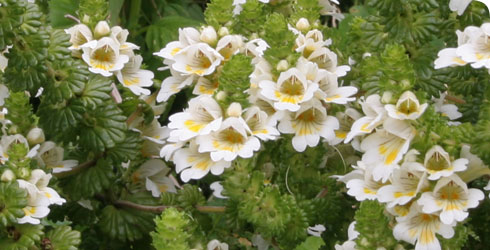Taxonomy
Euphrasia is a large genus, containing approximately 350 species of hemiparasitic root parasites with a widely disjunct bipolar distribution.
Within the genus, 15 sections have been recognised - section Atlanticae Pugsley contains only 2 species, both endemic to the Azores.
Phylogenetic studies (Gussarova et al, 2008) have shown this section to be rather distinct - it is apparently closer to nearctic annual taxa than perennial plants from the mountains of Oceania and Australasia.
Morphology
Euphrasia grandiflora is a short-lived perennial herb about 40cm tall.
It is erect or ascending, and usually has multiple branches.
Leaves are:
- opposite
- almost circular and flat
- 10–20mm long
- often hairless above
- rough, hairy below particularly on the veins
Floral leaves (bracts) are similar but smaller with less hairy margin and up to 12 pairs of obtuse to sub-acute teeth. Leaves and bracts blacken when dried.
Flowers have:
- calyx 5–7.5 mm long, campanulate, 4-lobed, villous in the sinuses
- corolla 13–16mm, white to lilac with purplish veins and yellow spots on lower lip and throat limb 2-lipped - the upper galeate, the lower longer, flat, patent, 3-lobed with emarginate lobes
- 4 stamens in two pairs of uneven length (didynamous)
- parallel loculi, spurred - one with a much longer spur than the other
- stigma capitate
- heart-shaped capsule 6–7.5mm that splits lengthwise releasing numerous seeds approximately 1.5mm in size
Diagnostic description
The 2 native endemic species are the only examples of the genus Euphrasia in the Azores.
They are easily distinguished from Eurasian/North African examples of the genus (sections Euphrasia and Angustifolia) by their:
- greater stature
- much larger flowers (more than 13mm)
- perennial habit
E. grandiflora differs from the Western Azorean endemic E. azorica in its:
- shorter calyx (less than 7.5mm as opposed to more than 8.5mm)
- shorter (7.5mm) obcordate, not cuspidate capsule
- more rounded foliage that blackens on drying - E. azorica foliage is more deltate and doesn’t blacken
- E. grandiflora tends to be taller and a more widely spreading plant, with a more conspicuous inflorescence, as the name suggests
Isolation and inbreeding may have led to subtle morphological differences between plants on the different islands:
- E. grandiflora on Pico have smaller, more glabrous foliage and shorter calyces
- on Sao Jorge, E. grandiflora more closely resembles the western E. azorica
Evolution
Research on the evolution of Euphrasia has shown that the Azorean species are very distinctive and suggests that they have been isolated from other species for a long time.
Both Azorean species are perennial with large flowers and these characters readily distinguish them from similar species found in continental Europe.
Genetics
The chromosome number and ploidy level of E. grandiflora (and E. azorica) are currently unknown. The European members of the genus are diploid (2n=22), tetraploid (2n=44) with triploid hybrids between them.
Toolbox
Glossary
Calyx
Sepals of a flower.
Capitate
Forming a headlike mass or dense cluster.
Corolla
Petals of a flower.
Cuspidate
Having a short abrupt point.
Deltate
Triangular leaf shape
Galeate
Helmet shaped.
Hemiparasitic
A parasite with chlorophyll - it is not wholly dependant on its host for nutrition.
Inflorescence
Group or cluster of flowers arranged on a stem.
Obcordate
Heart shaped.
